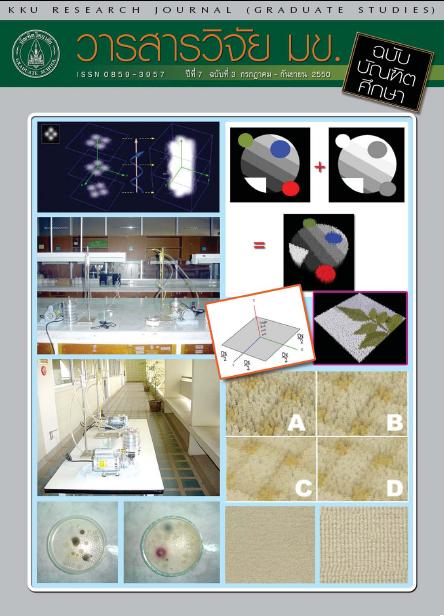Effect of Bottom Ash on Corrosion of Steel in Concrete(ผลกระทบของเถ้าก้นเตาต่อการกัดกร่อนของเหล็กเสริมในคอนกรีต)
Keywords:
Corrosion(การกัดกร่อน), Bottom ash(เถ้าก้นเตา), Current passed(กระแสไหลผ่าน), Chloride(คลอไรด์), Resistance(ความต้านทาน)Abstract
นำเสนอกำลังรับแรงอัดและการกัดกร่อนของเหล็กเสริมในคอนกรีตผสมเถ้าก้นเตา โดยแทนที่ปูนซีเมนต์ปอร์ตแลนด์ด้วยเถ้าก้นเตาในอัตราร้อยละ 0, 10, 20, และ 40 โดยน้ำหนัก อัตราส่วนน้ำต่อสารซีเมนต์ที่ใช้เท่ากับ 0.61 ชิ้นตัวอย่างทดสอบขนาดเส้นผ่านศูนย์กลาง 100 มม. สูง 200 มม. ฝังด้วยเหล็กกลมผิวเรียบขนาดเส้นผ่านศูนย์กลาง 12 มม. ยาว 200 มม. ไว้ที่ตรงกลางหน้าตัดตัวอย่างทดสอบ จำนวน 1 เส้น โดยแช่ตัวอย่างทดสอบให้บางส่วนจมในสารละลายโซเดียมคลอไรด์ความเข้มข้น 3% และต่อศักย์ไฟฟ้ากระแสตรง 5 โวลท์ เข้ากับตัวอย่างทดสอบให้ขั้วบวกต่อกับเหล็กที่เสียบในตัวอย่างทดสอบและขั้วลบต่อกับแผ่นเหล็กไร้สนิมที่แช่ในสารละลายเดียวกัน การทดสอบกระทำในห้องควบคุมอุณหภูมิที่ 23 ± 2 องศาเซลเซียส ความชื้นสัมพัทธ์ 50 ± 5% การประเมินค่าการกัดกร่อนของเหล็กเสริมโดยการวัดค่ากระแสที่ไหลผ่านตัวอย่างทดสอบวันละครั้ง ขั้นตอนและการทดสอบทำตามมาตรฐาน NT BUILD 356 จากผลการทดสอบพบว่า กำลังรับแรงอัดของคอนกรีตผสมเถ้าก้นเตาร้อยละ 10, 20 และ 40 คิดเป็นร้อยละ 95, 80 และ 59 ที่อายุ 28 วัน ตามลำดับ และคอนกรีตผสมเถ้าก้นเตาร้อยละ 10 สามารถต้านทานการแตกร้าวจากการเกิดกัดกร่อนของเหล็กเสริมได้ดีกว่าคอนกรีตควบคุม ส่วนคอนกรีตผสมเถ้าก้นเตาร้อยละ 20 และ 40 จะด้อยกว่าคอนกรีตควบคุมThis paper presents compressive strength and corrosion of steel in concrete containing bottom ash with Portland cement replacement dosage of 0%, 10%, 20%, and 40% by weight of binder. The water to binder ratio of 0.61 was used. Specimen size of 100 mm diameter and 200 mm height with a round bar of 12 mm diameter and 200 mm long at center of cross section is used. The specimen is partially immersed in 3% sodium chloride solution. A constant direct current potential 5 volts is applied across the specimen, the steel rod being positive electrode and a stainless sheet being negative electrode. The test is acted in control room at temperature 23 ± 2 ÌC and relative humidity 50 ± 5%. The corrosion of steel is predicted by measurement current passed the specimen once a day according to NT BUILD 356. From the test, it was found that the compressive strength of concrete with 10%, 20% and 40% bottom ash were 95%, 80% and 59% of compressive strength of control concrete, and the concrete with 10% bottom ash can resistance to crack from steel corrosion better than the control concrete, but the concrete with 20% and 40% bottom ash were inferior than the control concrete.



